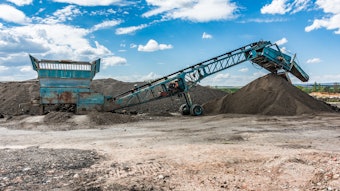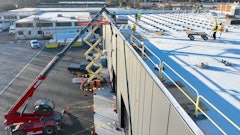Thousands of tons of old ceiling tiles will soon be diverted from local landfills thanks to a new agreement between Armstrong World Industries, the nation's largest manufacturer of acoustical ceiling systems, and Waste Management, the nation's leading provider of environmental services.
With the addition of more than 50 Waste Management material recovery facilities, and collection contracts with many of the nation's top construction companies, the new initiative is expected to significantly expand the existing Armstrong Ceiling Recycling Program.
Program Offers Alternative to Landfill Disposal The Armstrong Ceiling Recycling Program is the longest running program of its kind and enables commercial building owners to send ceilings from construction sites to an Armstrong ceiling plant as an alternative to landfill disposal.
As an Armstrong Certified Construction & Demolition (C&D) Processor, Waste Management will collect mineral fiber and fiberglass ceiling tiles that have been removed from commercial renovation and demolition projects. It will then store and prepare the tiles for shipment to the nearest Armstrong ceilings plant, where they will be used in the manufacture of new ceiling tiles. Armstrong designates new tiles made with high levels of recycled ceilings as Ceiling-2-Ceiling tiles.
Since the program began in 1999, Armstrong has recycled over 123 million square feet of old ceiling tiles. This represents more than 16,000 roll-off containers of discarded construction materials that would have otherwise been taken to landfills.
Provides Easy Access to Ceiling Recycling "As leaders in the ceiling industry, we continue to develop sustainable, innovative breakthroughs in both products and programs that provide valuable closed loop solutions to our customers," said Anita Snader, Environmental Sustainability Manager for Armstrong. "A key goal of our program is to provide easy access to ceiling recycling where and when a customer needs it. Our collaboration with Waste Management will enhance this offering allowing much more material to be recycled."
"This is a great resource for recyclable materials, said Jim Halter, Vice President of Construction Solutions for Waste Management. "The program expands the ways we're supporting our goal of finding more value in materials we collect, as well as developing a sustainable network with a major product manufacturer in the industry.
"Our goal is to capture as much value from the waste stream as we can," Halter added. "As a leader in environmental solutions, we are out to help contractors, developers, and architects achieve their green goals, whether that's through consultation, materials diversion, or innovative programs like our alliance with Armstrong."
Impact on Environment Is Significant
The environmental benefits from ceiling recycling are significant. For example, recycling just one ton of tiles saves 11 tons of raw materials, 1,892 gallons of potable water, and enough electricity to power a home for 1.4 months.
The Ceiling Recycling Program can contribute to LEED(®) points in the Construction Waste Management (MRc2) portion of the Materials and Resources credit. Selection of Armstrong Ceiling-2-Ceiling items with their high post-consumer content can contribute to LEED points in the Recycled Content (MRc4) portion.
For additional information on the Armstrong Ceiling Recycling Program, visit armstrong.com/recycling.
For additional information about Waste Management, visit www.wm.com or www.thinkgreen.com.
Armstrong World Industries, Inc. is a global leader in the design and manufacture of floors, ceilings and cabinets. In 2011, Armstrong consolidated net sales totaled nearly $2.9 billion. Based in Lancaster, PA, Armstrong operates 32 plants in eight countries and has approximately 9,100 employees worldwide.
Waste Management, Inc, based in Houston, Texas, is the leading provider of comprehensive waste management services in North America. Through its subsidiaries, the company provides collection, transfer, recycling and resource recovery, and disposal services. It is also a leading developer, operator and owner of waste-to-energy and landfill gas-to-energy facilities in the United States. The company's customers include residential, commercial, industrial, and municipal customers throughout North America.

![Img 1707[56]](https://img.forconstructionpros.com/files/base/acbm/fcp/image/2023/04/IMG_1707_56_.6437076c97961.png?auto=format%2Ccompress&fit=crop&h=191&q=70&rect=0%2C462%2C1920%2C1080&w=340)
















![Glp Porsche 072723 465 64ee42287c29e[1]](https://img.forconstructionpros.com/files/base/acbm/fcp/image/2024/03/GLP_PORSCHE_072723_465.64ee42287c29e_1_.65e88b8589b9c.png?auto=format%2Ccompress&fit=crop&h=135&q=70&rect=0%2C520%2C2250%2C1266&w=240)







